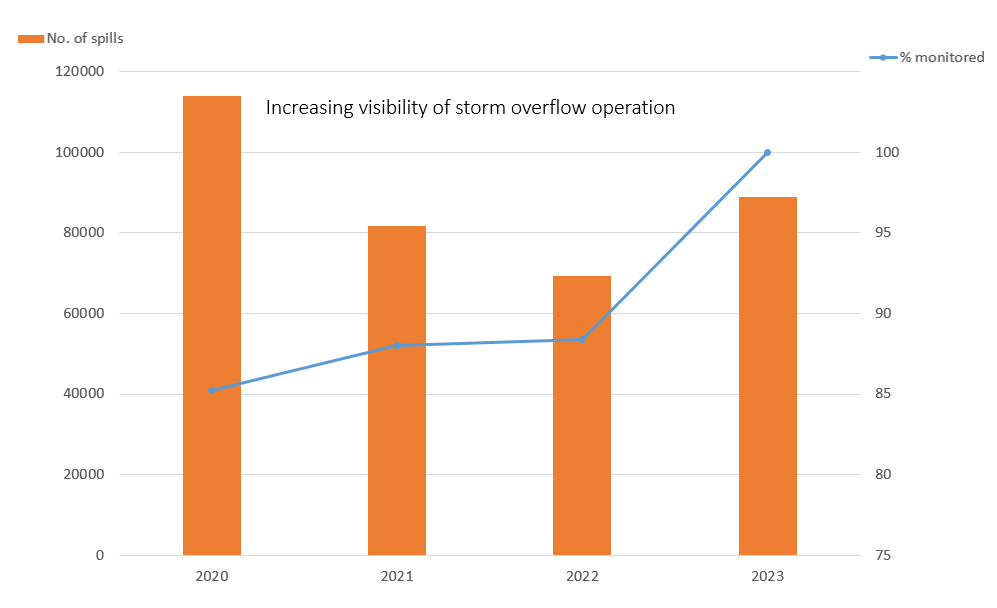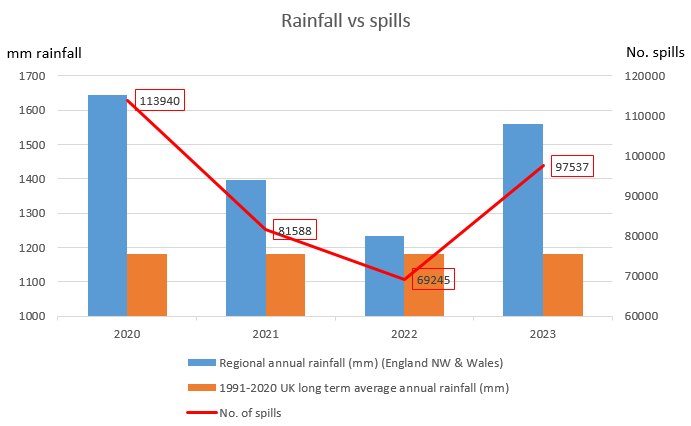EDM return data
Best ever visibility of performance
For the first time, we are now able to monitor the performance of all 2,264 storm overflows in the North West region. This provides the most complete dataset we have ever been able to report.
 What does the data show us?
What does the data show us?
The 2023 data is showing us:
- 97,537 Total number of regulatory storm overflow operations
- 45 Average number of operations per storm overflow
- 15% Reduction on 2020 baseline spill figures
- 3.5% Of the year on average when storm overflows are operating
- 31% Of storm overflows this year met the long term (2050) ambition of no more than 10 spills per year
You can download our 2023 data returns below:
The impact of rainfall and climate change
During dry weather the sewers in North West England are rarely more than 15% full. The extra capacity is there to carry rainwater in the same pipes.
Much of the North West’s sewer network is a “combined” system. These combined sewers – which are more prevalent in the North West than in some other regions – combine both foul water and drainage from rainfall, such as highways run off. In our region, 54% of our sewers are combined compared to an industry average of around 33%.
Storm overflows are part of the combined sewer system. They are a design feature that act as a pressure release valve when sewers fill up with rainwater, releasing water into rivers to reduce pressure on the system. If they didn’t do this, then sewage would back up in the system and flood homes, businesses and roads. There are more than 2,200 storm overflows within the wastewater system across the region.

The more rainfall, the more likely storm overflows will operate, automatically releasing a diluted mixture of sewage and rainwater into the environment. This is shown in the graph above. Remember – when it’s not raining, then our sewers are typically no more than 15% full.
As well as more combined sewers, the North West also has 28% higher average annual rainfall than the average for England and Wales. Because it’s rainfall that fills the sewers to their capacity, it’s rainfall that puts more pressure on the system. We are now seeing the impacts of climate change with changing rainfall patterns and increasing numbers of intense rainstorms. In the North West region Met Office data shows for 2023:
- 10 named storms
- 191 days of rainfall (52%) of the year
- Parts of the North West had 50% more rain than in 2022
- 2023 saw the wettest July on record in Lancashire, Merseyside and Greater Manchester.
As a result, the number of spills increased by 40% compared to the much drier year of 2022.
- 30% of this increase was down to the weather and more rainfall
- 10% of the increase was because of installing the remaining overflow monitors to capture data for the first time
We are starting to see an underlying improvement in performance due to investment projects carried out as part of our Better Rivers: Better North West programme. In 2023, storm overflows showed a 15% reduction on baseline spills in 2020, even with high rainfall and with the addition of more monitoring points meaning we now have full coverage for the first time.
We are committed to upgrading our sewer systems to meet changing public expectations and the increased pressures of climate change.
Ambitious investment programme
Now that we have full visibility of how all storm overflows operate in the North West we can prioritise our investment programme to tackle the sites spilling most frequently or with the potential to cause most impact first.
We have set out our proposals to our regulators for a record £13.7bn investment programme between 2025 and 2030. This includes:
- £3 billion for storm overflow investment
- Improving 437 storm overflows
- We are already making an early start at 150 of these sites
Investment will tackle the issue in a number of ways:
- Grey solutions - increased storage of storm water within the sewer system and increased capacity at treatment plants
- Blue solutions - separation of surface water out of sewer systems
- Blue/Green solutions - creating wetlands or reedbeds to clean storm water before it is returned to the environment
We are making a fundamental change to the way our sewer system has been designed and change on this scale cannot happen overnight. We are re-plumbing our drainage systems, building storage tanks to increase the capacity, separating rainwater out of sewers, and harnessing the power of nature to treat storm water before it is returned to the environment. Work has already started, and people are going to see much more of this over the next 25 years.